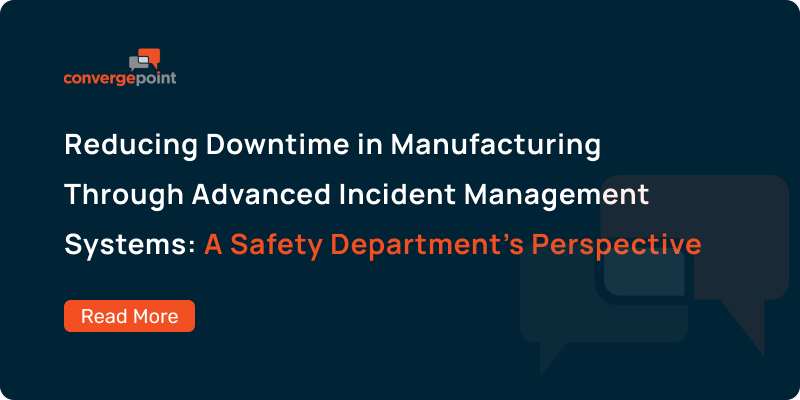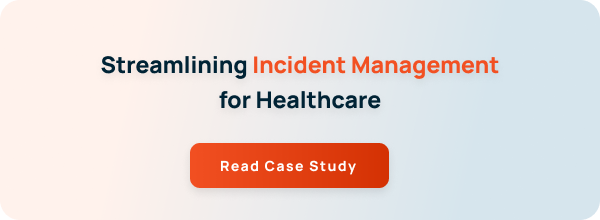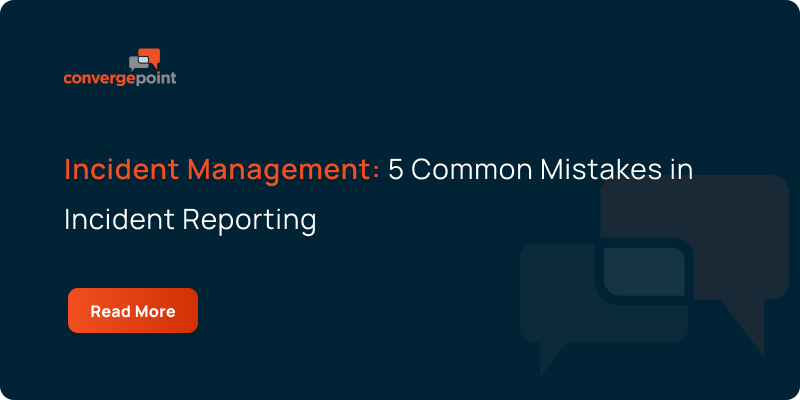
How Incident Management Software Can Speed Up Healthcare Incident Resolution
Healthcare institutions operate in high-stakes environments where even small delays in incident response can have serious consequences. Whether it's a medication administration error, patient injury, or breach of protocol, incident response must be immediate, structured, and well-documented. Unfortunately, many hospitals still rely on outdated reporting methods such as paper forms, Excel trackers, or siloed internal email systems, which delay responses, create inconsistencies, and complicate compliance audits.
For hospitals and healthcare networks facing increased scrutiny from regulators and internal quality improvement teams, digitizing the entire incident lifecycle is no longer optional. A comprehensive incident management software solution purpose-built for healthcare environments addresses these critical needs by centralizing reporting, automating task routing, and tracking progress from submission to closure.
ConvergePoint's Incident Management Software, built natively on Microsoft 365 SharePoint, empowers healthcare providers to accelerate response times, minimize legal and regulatory risks, and create a proactive culture of safety and accountability.
This article examines how healthcare organizations can transform incident response using purpose-built technology. It explores the operational, clinical, and compliance advantages of deploying incident management software tailored to the healthcare setting.
The Real Impact of Delayed Healthcare Incident Response
Before diving into how software can make an impact, it's important to understand the consequences of delayed incident management:
-
Increased Risk to Patient Safety: Delayed identification or investigation of incidents—especially related to medication, equipment, or procedural errors—can result in repeated harm or even fatalities.
-
Regulatory Penalties: Healthcare providers must comply with strict mandates from OSHA, CMS, The Joint Commission, and other bodies. Delays in reporting or poorly documented investigations can trigger fines or loss of accreditation.
-
Legal and Financial Exposure: Lawsuits arising from preventable incidents often hinge on how quickly and thoroughly an organization responds.
-
Operational Disruption: Investigating incidents without a structured system results in duplicated effort, communication lapses, and data silos.
Modern hospital compliance software must be capable of handling this complexity without creating bottlenecks. A purpose-built solution with embedded workflows and audit trails helps hospitals respond faster—and with more accuracy.
The Benefits of Using Healthcare Incident Management Software
Adopting a purpose-built software platform for incident tracking is not just about replacing paper. It introduces structural improvements that allow organizations to respond with precision. A centralized platform offers consistency across departments, reduces administrative workload, and eliminates dependency on informal communication methods. Moreover, it standardizes data collection, improves transparency, and enables real-time operational oversight.
For healthcare providers managing hundreds of incident types across multiple units, software like ConvergePoint transforms incident management from a reactive process into a well-defined operational function that feeds directly into quality improvement and compliance objectives.
Accelerating Resolution with ConvergePoint's Healthcare Incident Management Software
ConvergePoint Incident Management Software addresses these gaps with a structured platform designed to:
-
Centralized case submission
- Route tasks automatically based on incident type
- Provide full audit trails for defensibility
-
Create accountability across team
Here’s how the software supports faster and more accountable incident resolution in clinical and administrative environments.
1. Real-Time Case Submission Within SharePoint
Most delays start at the submission stage. Nurses or other frontline staff may not know where to submit an incident, or they may wait until the end of a shift to notify supervisors. ConvergePoint eliminates this friction by offering a SharePoint-based intake portal accessible through Microsoft 365.
The intake form is configurable by department and incident type, enabling healthcare workers to capture critical data immediately and without ambiguity. Access is controlled using SharePoint security groups, which assign permissions by role—ensuring the right users see the right cases.
Read Also: Building the Business Case: HR Case Management Software
2. Automated Routing and Workflow Logic
Once an incident is submitted, ConvergePoint’s automated workflows take over. Rather than relying on administrative staff or paper routing, the software automatically assigns the case to the appropriate manager or investigator based on pre-defined rules. These workflows are configurable to align with departmental protocols, and include escalation triggers if deadlines are missed.
3. Structured Investigation & Root Cause Documentation
The software provides a centralized structure for documenting investigations, assigning root causes, and tracking corrective actions. Every case is built with dedicated sections for investigative notes, contributing factors, and mitigation plans. Managers can assign follow-up tasks directly within the platform, along with due dates and supporting attachments.
This level of structure not only helps reduce recurrence of incidents but also builds a defensible record for compliance reviews.
4. Role-Based Access to Sensitive Case Data
With HIPAA and similar privacy regulations in place, hospitals must control access to sensitive case data. ConvergePoint enforces strict role-based permissions that define what each user can view or edit. Whether it's a compliance officer, unit manager, or external auditor, each stakeholder only sees what is relevant to their role.
The Permission Grid allows administrators to configure access at the field, section, or workflow level—giving IT and compliance leaders full control over information governance.
5. Embedded Collaboration Through Secure Case Discussions
Collaboration on an incident often involves multiple roles and departments. Instead of relying on untracked email conversations, ConvergePoint includes an internal Discussion Board for each case. This enables users to communicate, ask questions, and update each other—while maintaining a full log of those interactions.
Email notifications are triggered with each comment, and @Mentions notify users directly when their input is needed. This ensures faster coordination while maintaining a secure and reportable communication trail.
6. Scalable Deployment Across Facilities and Units
Hospitals and health systems often operate across multiple sites with varied workflows. ConvergePoint supports both centralized and decentralized incident reporting models, accommodating facility-specific forms, workflow rules, and team structures.
Administrators can manage settings globally or per location, and the software supports both named user and enterprise licensing to fit organizational needs.
Questions to Ask: How to Select Healthcare Incident Management Software
Are your incident response policies still type-written in a binder? Scattered across different folders or filing cabinets? This is an all-too-real situation for many organizations, and it’s a form of risk waiting to happen. Moving everything into incident management software is imperative — and so is choosing the right platform.
As you approach the task of centralizing and digitizing your incident management policies, ask yourself the following questions to make sure you’re investing in the right software solution:
-
Does the software support standardized and department-specific incident intake forms?
Hospitals must collect consistent, complete data while accounting for varied incident types—from medication errors to workplace injuries. ConvergePoint allows teams to configure intake forms by incident category, ensuring accurate data capture aligned with hospital risk management software and internal reporting protocols.
-
How does the system manage routing and escalation across departments and locations?
One of the leading challenges in incident reporting in healthcare is getting the right information to the right person quickly. ConvergePoint’s workflows automatically route cases based on category, location, or severity. Escalation rules flag unresolved tasks to supervisors, helping reduce delays in healthcare incident management.
-
What tools are available to help us track unresolved corrective actions?
Hospitals often lack a consistent method to follow through on root cause resolutions. ConvergePoint includes a corrective action tracker that links directly to the incident case. Managers can assign, monitor, and report on follow-up activities, supporting continuous improvement and effective use of hospital compliance software.
-
Can the software provide clear audit trails for regulatory compliance?
Audit readiness is a key concern for compliance officers. Every case in ConvergePoint includes a real-time, exportable audit trail that documents submission, investigation, decisions, and corrective actions—meeting documentation standards for CMS, The Joint Commission, HIPAA, and other healthcare regulatory compliance requirements.
-
Does the system support real-time oversight with dashboards and reporting?
Healthcare organizations need continuous visibility into emerging risks. ConvergePoint’s configurable dashboards provide role-specific views of open cases, overdue actions, and trends across units. This supports proactive oversight within your patient safety reporting system and improves decision-making.
-
How does the software protect sensitive data across user roles?
With HIPAA and internal policy requirements, hospitals need fine-grained control over who can view or modify incident records. ConvergePoint enables role-based permissions down to the field level, ensuring sensitive data is accessible only to authorized individuals—essential for a secure medical error reporting system.
-
Is the platform scalable across multiple facilities or hospital systems?
ConvergePoint supports both centralized and distributed compliance models. Whether you’re managing a single site or an enterprise hospital system, workflows and permissions can be tailored to meet the unique needs of each location while maintaining consistent governance—supporting scalable risk management in hospitals.
These questions should guide evaluation and confirm that the chosen solution meets regulatory, technical, and organizational expectations. ConvergePoint is designed to answer them with a track record of supporting healthcare systems at scale.
Building a Safer, Smarter Incident Response Framework for Healthcare
In an environment as high-risk and highly regulated as healthcare, incident response must be fast, structured, and complete. Delays or inconsistencies can have serious consequences—not only for patients and staff but also for regulatory and legal exposure.
ConvergePoint’s Incident Management Software offers healthcare organizations the ability to transition from reactive to proactive by removing process inefficiencies and creating a framework for continuous improvement. Built on Microsoft 365 SharePoint, the platform brings compliance, accountability, and speed into one secure, configurable system.
If your organization is still relying on email and spreadsheets for incident tracking, now is the time to adopt a scalable, audit-ready solution that truly supports healthcare compliance software goals.




